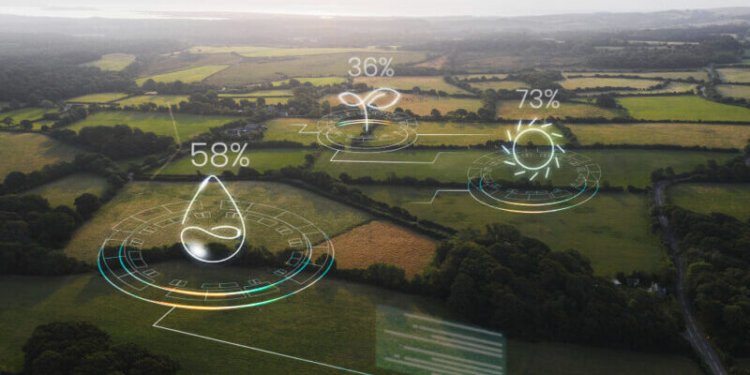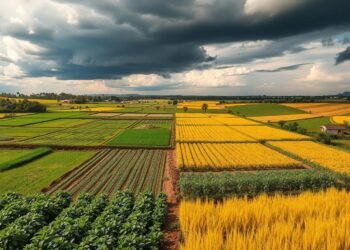Sustainable farming offers a beneficial approach to food production that respects our environment. With the population on the rise, agriculture must adapt. Conventional practices may prioritize speed over sustainability, often leading to environmental harm. On the other hand, sustainable methods safeguard soil, water, and air quality. By embracing practices that foster balance within nature, farmers can meet current food demands without compromising future resources.
Below are seven effective sustainable farming practices that contribute to a healthier future.
Understanding Sustainable Farming Practices
Sustainable farming methods emphasize practices like crop rotation, cover crops, and no-till techniques to improve soil health and fertility. These approaches nurture biodiversity by fostering diverse ecosystems where various crops can flourish.
For example, cover crops not only conserve soil moisture but also boost organic matter, reducing erosion risk. Sustainable agriculture also aims to lower pollution from chemical fertilizers and fossil fuel emissions, which enhances human health and food security. By adopting integrated pest management, farmers can lessen adverse effects on natural resources. Grasping these principles enables farmers to make choices that uphold their operations’ long-term sustainability and consider their environmental impact. They can responsibly manage crop residues and adopt renewable energy sources, while also improving food waste management through effective processing and packaging methods.
This understanding empowers farmers to develop sustainable food systems that provide healthy food for future generations while tackling climate change and protecting biodiversity.
Importance of Sustainable Agriculture
Sustainable agriculture promotes long-term environmental health and biodiversity by encouraging practices such as crop rotation and cover crops. These approaches enhance soil fertility and prevent erosion, helping to maintain soil health through increased organic matter and improved moisture retention.
Additionally, techniques like no-till farming and agroforestry help reduce pollution and minimize fossil emissions, which benefits the environment. By decreasing the use of chemical fertilizers and implementing integrated pest management, these methods support a healthier ecosystem. Economically, sustainable agriculture fosters stability for farming communities through labor-intensive methods that often yield better prices for sustainably produced food, leading to improved livelihoods. These practices can also lower input costs and reduce food waste via enhanced processing techniques.
Furthermore, sustainable farming addresses food security challenges by ensuring diverse food systems that can endure climate change effects, securing natural resources for future generations, and contributing to reduced greenhouse gas emissions, ultimately supporting human health and well-being.
Top 7 Sustainable Farming Practices
1. Crop Rotation
Crop rotation enhances soil health and fertility by encouraging a variety of crop types that add organic matter and nutrients.
For example, after planting a nutrient-demanding crop like corn, farmers might follow up with nitrogen-fixing legumes to replenish soil fertility. This method improves soil moisture, minimizes erosion, and supports beneficial microorganisms. Furthermore, rotating crops disrupts pest and disease cycles, a strategy important for integrated pest management.
As a result, there can be a substantial reduction in reliance on chemical fertilizers and pesticides, promoting better human health and lower pollution. Effective crop rotation strategies include planning sequences with cover crops and employing no-till farming techniques, which lower fossil emissions and protect the soil from erosion.
These practices contribute to sustainable food systems, ensuring food security for future generations while safeguarding natural resources and addressing climate change and biodiversity issues.
2. Organic Farming
Organic farming focuses on sustainable agriculture by prioritizing natural methods over synthetic inputs like chemical fertilizers. This approach includes practices such as crop rotation and cover crops, which help enhance soil fertility and reduce soil erosion. Organic farming promotes biodiversity by cultivating various crop types and fostering a diverse ecosystem that supports integrated pest management.
It also aims to improve soil health by increasing organic matter and maintaining soil moisture, leading to better resilience against climate change. However, organic farmers often face challenges such as higher labor-intensive processes, increased costs associated with processing and packaging sustainably produced food, and competition with conventional farming methods that rely heavily on fossil energy. The environmental impact of organic methods could be compromised by the need for consistent quality, limiting market access and overall food security for future generations.
Despite these hurdles, organic farming significantly contributes to reducing greenhouse gas emissions and the pollution associated with traditional agriculture, encouraging a healthier relationship with natural resources and promoting sustainable food systems.
3. Agroforestry
Agroforestry enhances biodiversity and soil health by combining trees or shrubs with crops and livestock, creating supportive habitats for various organisms. This diverse ecosystem promotes soil fertility through organic matter from fallen leaves and crop residues, improving soil moisture and preventing erosion.
Farmers adopting agroforestry can see economic benefits by lowering costs related to chemical fertilizers and boosting crop yields, leading to better prices for sustainably produced food.
Additionally, agroforestry contributes to climate change mitigation by sequestering carbon and reducing greenhouse gas emissions. Integrating renewable energy sources within these systems builds resilience against climate impacts, ensuring food security for future generations while promoting sustainable farming practices that combat pollution and enhance human health. By adopting integrated pest management techniques, agroforestry further decreases dependence on harmful pesticides. Remote sensing technology aids farmers in effectively managing their resources, optimizing productivity while preserving natural resources and reducing environmental harm.
4. Conservation Tillage
Conservation tillage employs methods like no-till farming and reduced tillage to enhance soil health and limit soil erosion. By leaving crop residues on the field, it boosts organic matter and maintains soil moisture, components important for soil fertility. This approach also fosters sustainable agriculture by capturing carbon and encouraging biodiversity, allowing various crop types and beneficial organisms to thrive.
However, farmers may encounter challenges, such as the requirement for morelabor-intensive practices and possible declines in immediate crop yields. These issues can be tackled through training on integrated pest management and leveraging remote sensing technology for optimized crop management.
Additionally, transitioning to renewable energy sources can help lower fossil emissions during farming operations, resulting in a reduced environmental impact. By concentrating on sustainable food systems, farmers can enhance food security for future generations while reducing pollution and food waste commonly associated with conventional agricultural methods. Sustainable farming encourages healthier food choices that benefit both human health and the environment.
5. Integrated Pest Management
Integrated Pest Management (IPM) reduces chemical pesticide use in sustainable farming by emphasizing natural solutions. This approach encourages beneficial insects and other organisms to manage pest populations, minimizing reliance on harmful chemical fertilizers that can lead to pollution and affect soil health. Farmers monitor pest activity through strategies like remote sensing technology, allowing them to collect accurate data on pest presence and crop types.
With this information, they make informed decisions about when to intervene. IPM combines biological methods, such as introducing ladybugs to eat aphids, and cultural methods, like crop rotation and cover crops, which disrupt pest life cycles and improve soil fertility. Mechanical controls, including traps and barriers, further assist in naturally managing pests.
This comprehensive system supports biodiversity, enhances soil moisture, and reduces greenhouse gas emissions, contributing to resilient food systems and securing food for future generations while lowering costs tied to excessive processing and packaging.
6. Water Conservation Techniques
Water conservation techniques such as drip irrigation, rainwater harvesting, and cover crops are important for reducing water usage in sustainable agriculture. These methods ensure that water is used efficiently, directly reaching plant roots and minimizing evaporation. By implementing cover crops, farmers can enhance soil moisture retention and reduce soil erosion, which improves overall soil health.
When these techniques are adopted, they can lead to higher crop yields without the need for chemical fertilizers, thus promoting food security. Advancements in technology enhance these techniques through remote sensing methods, which help monitor soil moisture levels and optimize irrigation schedules. This innovation allows farmers to make informed decisions, reducing fossil emissions tied to excessive water use.
Additionally, sustainable farming practices such as no-till farming and agroforestry improve biodiversity and help address climate change by lowering greenhouse gas emissions. Emphasizing responsible water management supports future generations by preserving natural resources and ensuring a stable food system that meets the needs of people and the environment while minimizing pollution and food waste.
7. Sustainable Livestock Management
Sustainable livestock management enhances environmental health and biodiversity by adopting practices that boost soil fertility and reduce erosion. Strategies such as crop rotation and cover crops improve soil moisture and organic matter while fostering crop diversity. Integrating livestock into these systems promotes natural interactions that improve overall health. Techniques like agroforestry provide shade and habitat, benefiting various ecosystems.
Additionally, farming methods like no-till farming and integrated pest management lessen dependence on chemical fertilizers and fossil fuels, decreasing pollution and greenhouse gas emissions. These strategies support animal welfare and increase productivity by creating healthy environments for livestock.
As a result, sustainable livestock management secures food systems for future generations by improving food security, minimizing waste from processing, and promoting eco-friendly practices that combat climate change. By encouraging renewable energy and conserving resources, this approach also safeguards essential natural assets for agricultural success.
The Role of Technology in Sustainable Agriculture Practices
Technology enhances the effectiveness of sustainable agriculture practices through tools like remote sensing technology. By providing data on soil moisture, crop types, and environmental conditions, farmers can make informed decisions that improve soil health and fertility. This helps reduce soil erosion and pollution while promoting biodiversity.
Precision agriculture tools also contribute to reducing the environmental impact of farming activities by enabling practices like crop rotation and no-till farming. These methods minimize the use of chemical fertilizers and other pollutants, leading to lower greenhouse gas emissions. Data analytics and IoT allow farmers to monitor their operations in real-time, optimizing resource use such as water and renewable energy. This approach increases food security for future generations and supports sustainable food systems.
Sustainable Agriculture and Climate Change
Sustainable agriculture reduces greenhouse gas emissions and pollution, addressing climate change. Practices like crop rotation and cover crops enhance soil fertility and health by boosting organic matter and water retention, improving soil moisture. By minimizing erosion and employing methods like no-till farming, farmers protect natural resources. Integrated pest management decreases dependence on chemical fertilizers, further lowering environmental impact.
Farmers can adopt renewable energy to power their operations, reducing reliance on fossil fuels. Agroforestry promotes biodiversity by integrating various crops and livestock, supporting food security for future generations. Supportive policies can lead farmers to embrace more labor-intensive practices like composting and responsible packaging, which curb food waste. Remote sensing technology offers valuable data for informed decision-making in sustainable farming.
This holistic approach not only promotes human health through safer food production but also builds resilience against climate challenges, ensuring food systems succeed amid changes.
Resources for Implementing Sustainable Farming Practices
Various online platforms and organizations provide grants and financial support to farmers looking to transition to sustainable agricultural methods. These resources back initiatives like cover crops, crop rotation, and agroforestry, enabling farmers to improve soil health and tackle erosion. Local agricultural extension services offer valuable assistance by guiding farmers in these practices and providing personalized advice on crop management and soil care.
They also help develop integrated pest management approaches that encourage biodiversity and lessen dependence on chemical fertilizers. Educational materials, including workshops and online courses, are accessible for farmers to learn about sustainable techniques such as no-till farming and effective water management for better soil moisture. These programs often aim to cut down on food waste and packaging while enhancing food systems and security.
They highlight the adoption of renewable energy and remote sensing technology to reduce carbon emissions and minimize agriculture’s environmental footprint. By embracing these sustainable practices, farmers can create a healthier future for upcoming generations.
Goal 1: Achieving Global Food Security Through Sustainable Agriculture
Sustainable agriculture practices can enhance global food security through several strategies. Crop rotation helps maintain soil fertility by rotating different crop types, which reduces soil erosion and promotes biodiversity. Cover crops boost soil health by increasing organic matter and retaining moisture, while no-till farming preserves crop residues, preventing pollution and improving soil structure.
Integrated pest management minimizes chemical fertilizers and supports human health by reducing harmful pesticide use. The use of renewable energy further cuts fossil emissions, making farming more sustainable. Technology, like remote sensing, allows farmers to monitor crop types and manage resources efficiently, helping to reduce waste and greenhouse gas emissions. Governments and organizations can promote these practices by providing training for labor-intensive methods and supporting policies that favor sustainably produced food.
By improving processing and packaging standards, they can also increase consumer awareness and demand for environmentally-friendly options.
FAQ
What are the top 7 sustainable farming practices for promoting environmental health?
- Crop Rotation: Alternating crops to improve soil health.
- Cover Cropping: Using plants to protect soil during off-seasons.
- Reduced Tillage: Minimizing soil disturbance to maintain structure.
- Integrated Pest Management: Using natural predators for pest control.
- Organic Fertilizers: Employing compost and manure instead of synthetic chemicals.
- Agroforestry: Integrating trees with crops for biodiversity.
- Water Conservation: Implementing drip irrigation to reduce water use.
How can crop rotation contribute to sustainable farming?
Crop rotation helps prevent soil depletion, reduces pests and diseases, and improves soil health.
For example, rotating legumes with cereals enhances nitrogen levels in the soil, while alternating deep-rooted and shallow-rooted plants improves nutrient uptake and soil structure. Implementing this practice fosters greater biodiversity and resilience in farming systems.
What role does organic farming play in sustainability?
Organic farming enhances sustainability by promoting soil health, reducing chemical use, and encouraging biodiversity. Actionable practices include crop rotation, composting, and integrated pest management. For example, using cover crops improves soil fertility while minimizing erosion and pest issues.
How does permaculture enhance sustainable agriculture?
Permaculture enhances sustainable agriculture by promoting biodiversity, using companion planting, and implementing rainwater harvesting. For example, integrating nitrogen-fixing plants with crops improves soil health, while mulching conserves moisture, reducing the need for irrigation and chemical fertilizers.
What methods can farmers use to conserve water and reduce waste?
Farmers can conserve water by using drip irrigation, which delivers water directly to the plant roots, and by implementing rainwater harvesting systems. Additionally, practicing crop rotation and planting drought-resistant crops can reduce water usage and waste. Mulching also helps retain soil moisture.





